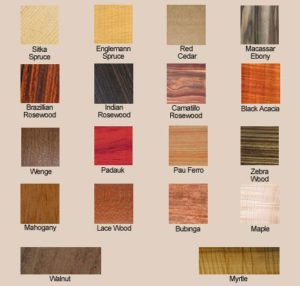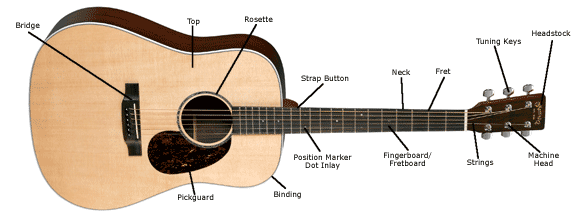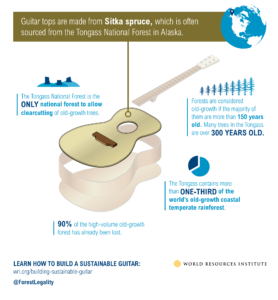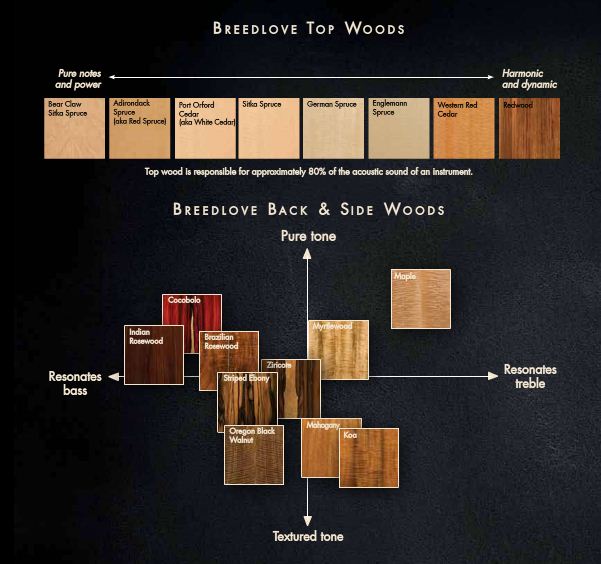No products in the cart.
Blog
Sustainable Supply of Instrument Tonewoods
The sustainable supply of Tonewoods is at a critical junction, following years of clear cutting forests that besides construction timber, produce the woods needed for acoustic instrument building.
Among the thousands of timber and lumber species and varieties globally grown, there are only a small number that carry the distinction of being a tonewood. Tonewoods possess tonal properties that make them good choices for use in acoustic stringed instruments. As a rough generalization it can be said that stiff-but-light softwoods are favored for the soundboards or soundboard-like surface that transmits the vibrations of the strings to the ambient air, while Hardwoods are favored for the body or framing element of an instrument.
Before we go into detail on the various tonewoods, we should maybe look into the conversation if different tonewoods really matter for guitars and other string instruments, now that sound technology has come so far. A case can be made that for solid body electric instruments, the electronics and wiring basically define the tone a player is looking for, even though there are many differing and opposing opinions here. However we can honestly say that acoustics and semi-acoustics, even those outfitted with an electronics package, are primarily driven by the various tonewoods and their resonance tonal qualities.
 So which are the soft and hardwoods mostly used in instrument making and why are we currently in somewhat of a production crisis due to lack of availability of certain woods?
So which are the soft and hardwoods mostly used in instrument making and why are we currently in somewhat of a production crisis due to lack of availability of certain woods?
The Softwoods used in instrument making are:
• a variety of Spruces. Spruces are often used in the sound boards of instruments from the lute, violin, oud, mandolin, guitar, and harpsichord families; as well as the piano. Spruce is particularly suited for this use because of its high stiffness-to-weight ratio. Commonly used varieties are old growth Sitka or Alaskan spruce, Adirondack or Red spruce, Engelmann spruce, and Picea abies, variously known as Norwegian, German, Alpine, Italian or European spruce.
• Cedars. In particular Western Red cedar (not a true cedar however), has since the 1950s been used in the tops of classical guitars and to a lesser degree in steel string acoustic guitars.
• Yew was once widely used for lute bowls and other softwoods, such as redwood and Douglas fir have been used to a limited degree, but hardly ever commercially.
The Hardwoods used in structural acoustic instrument making are mostly:
• Maple is traditionally used for the backs and sides of violin family instruments. It is also frequently seen in acoustic guitars and mandolins. Most Fender electric guitars feature maple necks (it is one of the hardest and most stable tonewoods, so it is often used in the neck because of its ability to withstand high tension). Hard-rock maple is commonly used for wooden tripods for its vibration dampening properties. Variations of maple (commonly maple wood with flamed or quilted grains) are used on the tops of electric guitars for aesthetic purposes. The very sturdy frame of the modern piano is usually made of maple or of beech.
• Mahogany may be used in the tops of some guitars as well as the back, sides, and necks of instruments of the mandolin and guitar families. Mahogany may also be used for the solid bodies of electric guitars, such as the Gibson Les Paul. Due to lack of availability other similar woods are used as mahogany replacements, such as Toona, Khaya, Meranti, Agathis, Nato wood and Sapele. Some of these alternatives are Mahogany family timbers.
• Rosewoods are often used in the back and/or sides of guitars and mandolins and fretboards on guitars. The most sought-after variety, Brazilian Rosewood has become scarce and expensive due to demand and illegal harvesting which in turn has led to severe trade restrictions (embargo). The most widely used rosewood now is east Indian Rosewood, often paired with a spruce top for steel string guitars and with spruce or cedar for classical guitars.
• Koa is traditionally used for ukuleles. Koa is also used for steel string guitars mostly because of its beauty and compressed dynamic range.
• Several varieties of Ebony are often used in many types of instruments for fingerboards, tailpieces, tuning pegs, and so forth due to its attractive appearance, smoothness to the touch, hardness and wear resistance. . Ebony is often dyed to make it appear more uniformly black than the natural wood, which sometimes shows brown streaks.
• Cocobolo is used in upper-end clarinets and guitars.
• Tasmanian/Australian Blackwood
• Walnut is often used for the backs and sides of guitars and mandolin family instruments.
• Ash, Alder and Basswood are commonly used for the bodies of electric guitars for their stiff structural properties.
While designing an instrument for commercial production, a luthier may be guided by perceived differences in acoustic properties of a certain tonewood, but will also take into consideration the aspects of Availability, Stability, Cosmetic properties such as the color or grain of the wood, Tradition and Size (Some instruments require large pieces of suitable wood)
 This is the first blog in a series of 6 tonewoods in search of answers how to make tone woods used for instrument building sustainable for the long term. To build an acoustic guitar, we first need to choose a wood for the soundboard (the top of the guitar), which determines most of the guitar’s tone, or quality of sound. We want a wood that is both stiff and light, which helps it transfer the most sound from the vibrating strings. The best slabs of wood will actually ring like a wine glass when tapped.
This is the first blog in a series of 6 tonewoods in search of answers how to make tone woods used for instrument building sustainable for the long term. To build an acoustic guitar, we first need to choose a wood for the soundboard (the top of the guitar), which determines most of the guitar’s tone, or quality of sound. We want a wood that is both stiff and light, which helps it transfer the most sound from the vibrating strings. The best slabs of wood will actually ring like a wine glass when tapped.
Spruce
We’re starting with Spruce as the most popular wood used for guitar tops, and recognizable by its pale color and (usually) understated figuring. The reason for its popularity is its middle of the road tonal properties that makes it a very good ‘all-rounder’. Sweet, and smooth, but not outrageously bright, yet with enough warmth, such that it doesn’t sound thin. Spruce sounds good when combined with just about any other tonewood. In addition, it also has pretty good projection and volume to boot.
Spruce is a common species of wood, adding to its guitar material credentials. Sitka spruce is the most commonly found type, with grain varieties such as ‘bear claw’ adding to the aesthetic appeal. Sitka is characterized by is clear fundamental harmonics. This and the availability factor makes old-growth Sitka spruce one of the favorites for guitar soundboards. Unfortunately however, old-growth Sitka spruce offers a case where sustainable forest management and conservation are not mutually exclusive, but where perfectly legal wood may nonetheless come from environmentally destructive clear-cutting primary forests.
Sitka spruce is a giant spruce native to coastal temperate rainforests, ranging from the U.S. Pacific Northwest, up to Canada and into Alaska. It is one of the largest, most commercially-viable woods, with old-growth stands including many trees over 600 years old and 200 feet tall. Thanks to their long, slow growth, these old-growth trees have tight growth rings that give them a good sound in instruments, with little of the cellulose fiber between rings that can deliver poorer tone. Young Sitka spruce grows quickly and are perfect for construction, but have too much cellulose fiber for instruments. The older trees are, pound-for-pound, stronger than steel. Once their wood was even used for propellers in airplanes.
Other spruce varieties have also long been used in instruments. European spruce from the Alps was used in Stradivarius violins. The first steel-string guitars from the early 20th century were made of Adirondack spruce. The sounds created by musicians ranging from cellist Yo-Yo Ma to country legend Johnny Cash were produced from instruments made of spruce.
Sitka Spruce in Alaska’s Tongass National Forest
Today, the conversation about Sitka spruce harvesting centers around one place: the Tongass National Forest in southeastern Alaska, a 17-million-acre swath that stretches across 500 miles and is the largest national forest in the United States. One of the most ecologically diverse regions in the country, the Tongass holds a third of all of the world’s temperate rainforests. Its Sitka spruces are among the oldest and largest in existence – some were alive when Columbus arrived in North America – and provide essential environment for salmon, bears and bald eagles. Tongass tourism is a billion-dollar business each year.
While Sitka spruce is not listed as endangered under the CITES Treaty (the multilateral treaty to protect internationally-traded plants and animals)https://www.cites.org/ , it is at the center of debates over sustainable forest management in the United States. The Tongass old-growth Sitka spruce forests are disappearing due to clearcutting subsidized by the U.S. Forest Service at a cost to taxpayers of $20 million annually. Estimates show that more than half the original old-growth forests have already been lost and, at current harvest rates, these forests will be eliminated in the next few decades. Clearcutting old-growth Sitka spruce threatens salmon fisheries, tourism and the biodiversity of the region, yet is allowed because of the relative abundance of young trees, which the law sees as identical to the oldest in the Tongass. In early July 2016, the previous administration proposed phasing out cutting of old-growth in the Tongass over the next 16 years. Many biologists and environmental activists believe, however, that this should happen on a much shorter timescale.
 Innovators in the guitar industry are pushing for sustainable Sitka spruce harvesting. Tom Bedell of Bedell Guitars and Breedlove Guitars was leading the Musicians for Forests campaign,http://clearcutfreemusic.com/ which called for an industry-wide moratorium on clear-cut Sitka spruce by the end of 2016. This would transform the guitar industry’s traditional supply chain for Sitka spruce and provide an example for other higher-volume supply chains. Given the high profile of the music industry, this campaign had the potential to influence timber industry firms, consumers, and lawmakers. Bedell’s proposal would allow existing inventory of Sitka spruce to be “grandfathered in” to post-2016 guitars, but would limit future tonewood purchases to salvaged or selectively harvested trees only. While this would raise the cost of raw materials marginally, it would ensure a higher quality product with a long-term supply.
Innovators in the guitar industry are pushing for sustainable Sitka spruce harvesting. Tom Bedell of Bedell Guitars and Breedlove Guitars was leading the Musicians for Forests campaign,http://clearcutfreemusic.com/ which called for an industry-wide moratorium on clear-cut Sitka spruce by the end of 2016. This would transform the guitar industry’s traditional supply chain for Sitka spruce and provide an example for other higher-volume supply chains. Given the high profile of the music industry, this campaign had the potential to influence timber industry firms, consumers, and lawmakers. Bedell’s proposal would allow existing inventory of Sitka spruce to be “grandfathered in” to post-2016 guitars, but would limit future tonewood purchases to salvaged or selectively harvested trees only. While this would raise the cost of raw materials marginally, it would ensure a higher quality product with a long-term supply.
Unfortunately the campaign only found 793 supporters to sign the petition with a 100,000 targeted objective. Whether it was insufficient marketing support to bring the issue to millions of guitar players or the growing trend to “not getting involved”, the issue will only become more seriously profiled as the years go by. “There was a price to pay”, as John Popper sang in Blues Traveler’s 1994 hit song “Price to Pay” on the 6 time Platinum album “FOUR”.
Tonewoods represent only a fraction of the Sitka spruce available in the Tongass, yet these crucial old-growth forests are being wiped out by clearcutting, much of it going to East Asia as cheap construction timber. In the case of Sitka spruce, legality is not always synonymous with sustainability. There is no excuse in a wealthy, industrialized country with strong forest management capacities for failure to balance demand with sustainable supply. With proper forest management, the Tongass contains more than enough trees to supply the string instrument market with sustainable, top-quality wood, and the guitar industry can help preserve this national treasure. The future of tonewoods is pretty much intertwined with the future of the Tongass.
What are the Alternatives
Engelmann spruce is of economic importance for its wood, harvested for paper-making and general construction. Wood from slow-grown trees at high altitude has a specialized use in making musical instruments such as acoustic guitars, harps, violins and pianos. Engleman spruce is typically from North America, and has a somewhat warmer, creamier tone than Sitka. Besides harvesting and clearcutting, the Engelman spruce has a natural enemy in the Spruce beetle which has been destroying almost 500,000 acres or the equivalent of 6 million trees per year. Another tone wood alternative used in early instrument building is the Adirondack spruce with a louder and brasher tonality.
Cedar is probably the second most popular material for guitar tops, and can generally spotted by a color that tends more towards a red-brown. When compared to spruce, cedar is lot less dense. This makes it quieter, less bright, with less sustain. The upshot, however, is that Cedar is much warmer, and takes less time to reach its full tonal potential. As a result, Cedar is a popular choice with finger-style players.
Worldwide there are more alternatives available, but will economically increase the dependency on foreign supply and trade tariffs.
The sustainable production of tonewoods in the US especially, is currently at a critical junction and instrument pricing will be affected the manufacturers predict, demanding to support a clear strategy for sustainability to keep quality solid wood acoustic instruments available.

